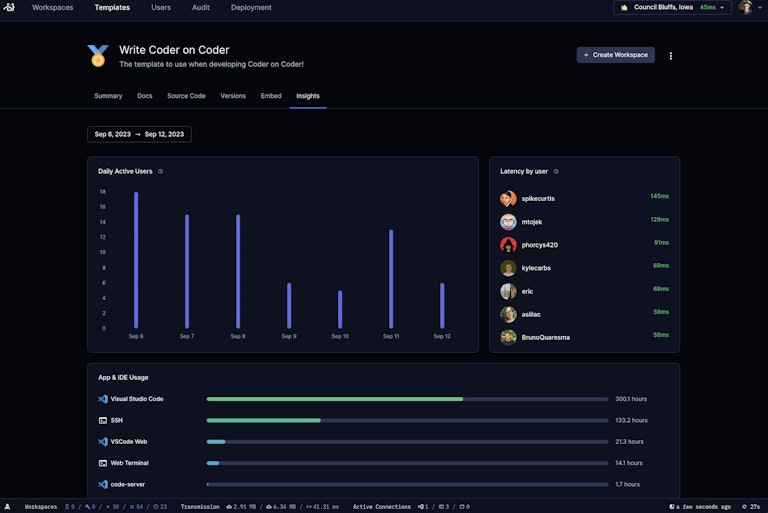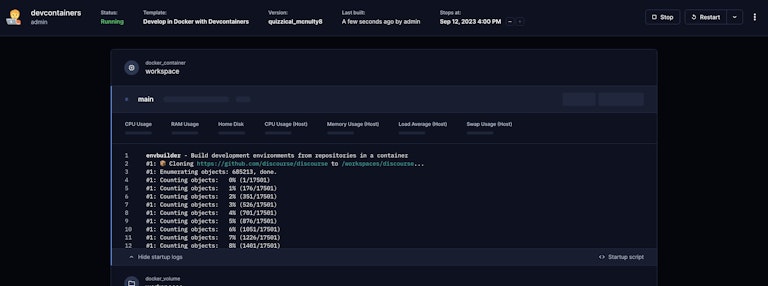Announcing Coder 2.0: Keep Developers In Flow

Keep developers in flow.
It’s not just a mantra here at Coder.
It’s the mission that guides the company. And it’s the reason
we’re releasing a new version of our software. Let me explain.
Coder Provides the Most Advanced Self-Hosted Cloud Development Environment
Coder provides cloud development environments (CDE). What does that mean? According to Gartner: “CDEs provide remote, ready-to-use access to a cloud-hosted development environment with minimal effort for setup and configuration. This decoupling of the development workspace from the physical workstation enables a low-friction, consistent developer experience. CDEs comprise elements of a traditional Integrated Developer Environment (IDE), such as code editing, debugging, code review and code collaboration. They increasingly include ML-based coding assistants and integrate with DevOps platforms". Gartner predicts that, “by 2026, 60% of cloud workloads will be built and deployed using CDEs".
We know that CDEs are not only a critical component, but they’re the future of development.
But there’s a catch.
Most CDEs are SaaS — and that’s a problem.
Why?
Because CDE are still an early adopt technology. That means most organizations adopting CDEs are sophisticated software development shops. For these organizations, software is critical to their digital transformation. And that means their software developers are core to their business strategy. These early adopters tend to fall in one of two profiles:
Digital-native organizations. Born in the cloud? If so, you’re a digital-native organization. You probably offer a SaaS or digital experience, like Netflix or Uber. Software is core to your business strategy, and developers are the kings and queens of your value generation. You invest heavily in acquiring the best developer talent. Better developers leads to competitive advantage. But let’s be honest. You need all the nerd knobs. You’re already developing in the cloud, but with an expensive homegrown cloud development solution that requires five or more full-time employees to mange it. You can’t rely on an overly opinionated SaaS offering that dictates your IDEs, infrastructure, or CI/CD integrations. You need flexibility. You need a deployable CDE solution that gets your developers onboarded and coding on day one.
Digital-forward organizations. You’ve stood the test of time and offer the best manufacturing, financial services, retail, or utilities offering in your market. You aspire to be digital-native, but you’re encumbered with a legacy architecture. And regulations. Oh, the regulations. Your developers lead the charge in your digital transformation, but you can’t expose the company to undue risk. SaaS won’t cut it. You need a CDE that you can deploy and configure in your private, public, or multicloud environment. SaaS solutions don’t meet regulatory requirements and certainly can’t work in air-gapped environments. In fact, chances are you’re repatriating apps as you read this. You need a solution that provides SaaS-like ease of use, but the governance and portability of software.
Coder offers a self-hosted cloud development environment (CDE). We’re deployed at some of the largest, most advanced companies in the world. Digital native? Coder customers serve a combined 1.6 billion SaaS users. Digital-forward? In financial services alone, Coder customers control $22.8 trillion in assets under management, roughly the same as the United States' GDP.

Introducing Coder 2.0
Coder has developed a CDE solution that balances the flexibility of deployable software with the ease-of-use of SaaS. We’ve worked hard to meet early adopters where they are: With a solution that enables developers to shift from local workstations to cloud-based workspaces. The capabilities we’re announcing today further this goal.
Specifically, we’re announcing Coder 2.0 — the second major release of our cloud development environment. The new capabilities in Coder 2.0 are available in our open source software. In our most significant release, we:
- Empower developers with Envbuilder to self-serve with Dev Containers. At the core of Coder is the idea that developers need autonomy and control over their environment — but without exposing the company to risk. Enter Developer Container, an emerging spec pioneered by Microsoft. Dev Containers enable developers to configure and save their entire development environment as metadata in a devcontainer.json file. Now developer workspaces can be expressed entirely as code, making it easier to spin up, replicate, and port developer workspaces. Coder has always provided a developer workspace abstraction. In Coder 2.0, we implement support for Dev Container as the underlying spec defining this workspace. Coder Environment Builder — or Envbuilder for short — is a new capability that makes it effortless for developers to implement Dev Containers, all without straying from the golden infrastructure path established by their Platform Engineering teams.

- Enable Platform Engineering teams to operate anywhere easily with a Template Registry. Workspaces are Coder’s abstraction for developers. Templates are the abstraction for Platform Engineering teams. Templates are Coder’s abstracted configuration capability that leverage the Terraform binary under the hood to support CDE provisioning across any infrastructure or cloud (and, no, we’re not affected by HashiCorp’s move to the BSL license). Available in Coder 2.0 (Sept. 27) is our Template Registry, a way to discover, browse, and contribute coder Templates. We’re launching the registry with 250 Coder Templates and modules, with more than 100 coming from our community. Maybe you built the best way to configure Coder for Jupyter Notebooks on Google Cloud using JFrog Artifactory and GitHub. Great! Share the template in our registry. We make it easy to get started with Coder. Expect the Template Registry to be the de facto way the Coder community shared Coder Open Source knowledge.
- Ensures a frictionless experience with single-click integration with JFrog. Templates greatly simplify the deployment of Coder as self-hosted software. But we didn’t stop there. We see a future where deployable, self-hosted software is as easy to implement as SaaS. We first demonstrated this with our JetBrains integration. Today, with Coder 2.0, we’re announcing an integration with JFrog. More than 60% of Coder customers are JFrog customers. Sure, you could configure JFrog Artifactory to work with Coder using Templates — but we wanted to make it one-click simple. With today’s release, you can automatically connect JFrog Artifactory as the backend system to store Coder elements. Moreover, Coder then exposes JFrog Xray metadata directly in the Coder UI to shift vulnerability assessment data left directly to the developer. Now developers can see if their workspaces are using known safe or known vulnerable assets — all without leaving their workflow.
Get Started With Coder 2.0 Open Source
Coder 2.0 is available on September 27, 2023. Several of the capabilities are already available in our open source software today. To get started, you can:
- Download our open source from GitHub. You can experience Dev Containers and JFrog integrations today by downloading Coder 2.0 from our GitHub repository. The Template Registry will debut on September 27, 2023 on a special webinar designed to go deep on Coder 2.0 capabilities. Register now to get your front row seat.
- Swing by the booth at JFrog swampUp 2023 in San Jose, CA. JFrog CTO and cofounder, Yoav Landman, will demonstrate the JFrog and Coder integration live as part of his keynote at JFrog’s user event, swampUP, at 9:00 AM PT today. If you’re attending, stop by! We’ll have a booth in the sponsor pavilion with full demonstrations of all Coder 2.0 capabilities.
- Request a trial of Coder Enterprise 2.0. Want to experience how Coder 2.0 can solve your developer productivity challenges at scale? Request a trial of Coder Enterprise 2.0. Based on Coder Open Source, Coder Enterprise adds governance, security, and observability capabilities that Platform Engineering and DevOps teams need to scale CDEs in production.
We’re Just Getting Started On Solving Developer Productivity Challenges
Today marks a significant milestone in Coder’s journey. Coder 2.0 is a self-hosted software solution that leads the market for cloud development environment solutions. But we’re just getting started.
Moving forward, you can expect Coder to focus on systematically removing obstacles that thwart developer productivity. Developer onboarding taking too long? Build times too slow? AI code assistance too difficult? We’ve got you back. After all, developers are some of the most critical — and expensive — assets in the digital era. That’s way we’re laser focused on providing a fantastic developer experience by keeping your developers productive.
Coder has arrived. We’re a new player in the developer experience market.
Trust Coder to keep your developers in flow.
Subscribe to our newsletter
Want to stay up to date on all things Coder? Subscribe to our monthly newsletter and be the first to know when we release new things!


